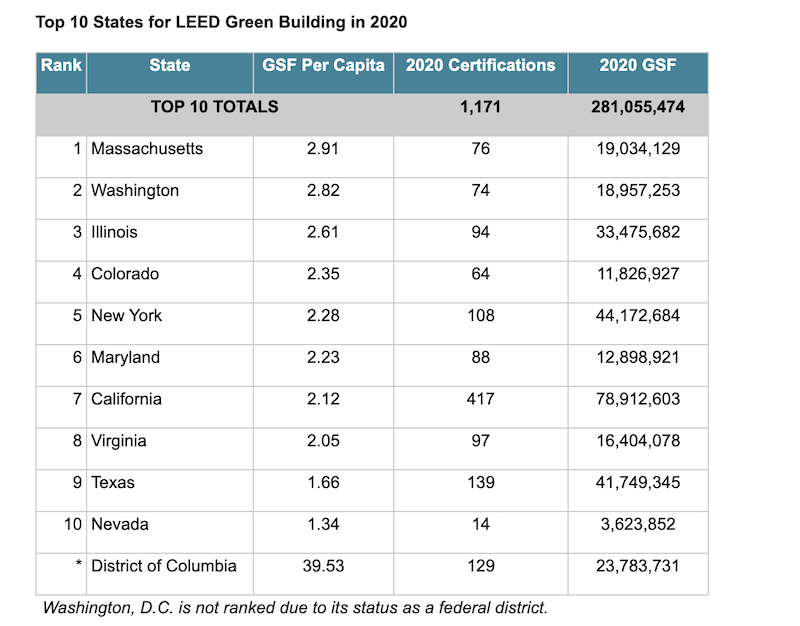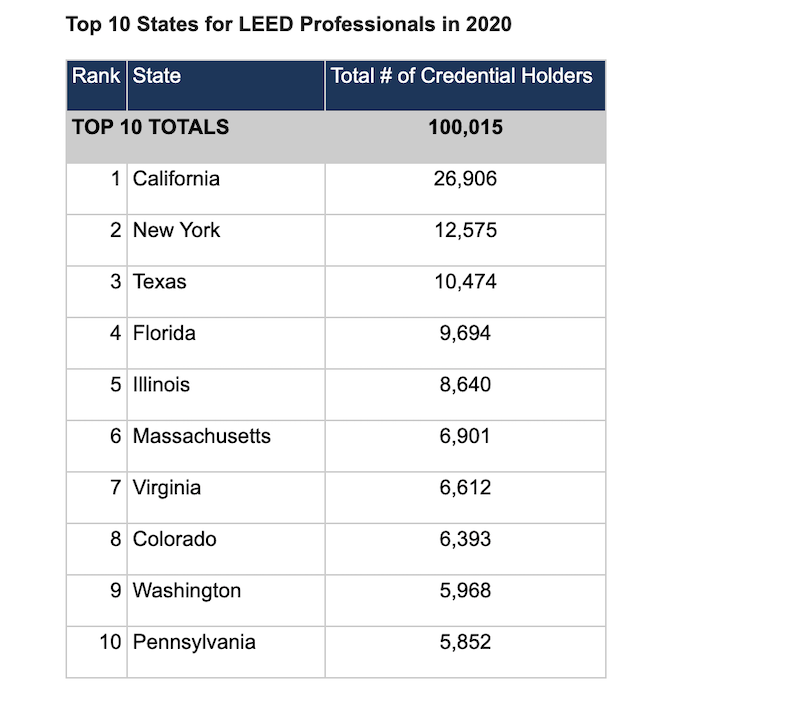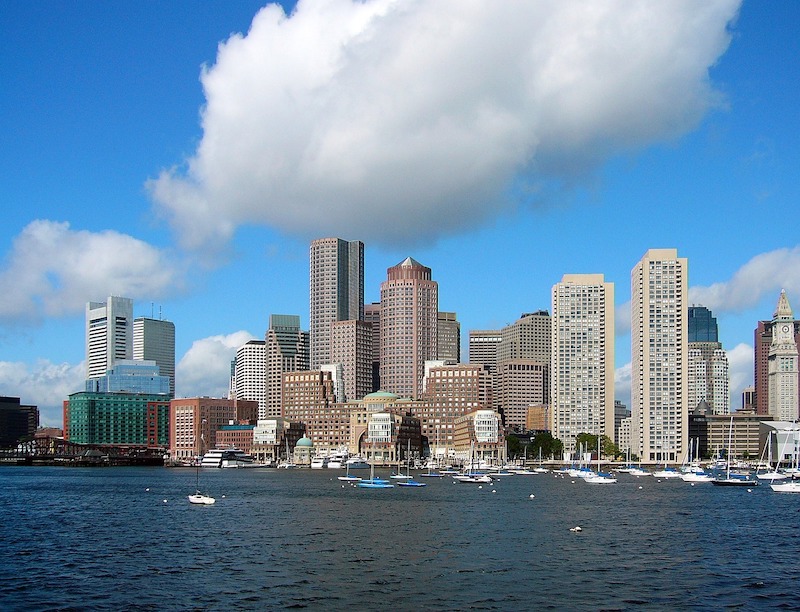The U.S. Green Building Council (USGBC) released its annual list of the Top 10 States for LEED green building with Massachusetts leading the country in 2020 with the most certified square feet per capita. Across the top states, more than 60% of certifications were office, healthcare, higher education and K-12 projects. This year, USGBC also released a ranking of states with the most LEED professionals with California taking the top spot. Collectively, the 2020 rankings represent 1,171 certified LEED buildings and spaces, and more than 100,000 green building workers.
“If we are to rebuild an economy that supports our health and our planet, we must lead with changing the way we design and build,” said Mahesh Ramanujam, president and CEO of USGBC. “Last year was a stark reminder that the quality of our buildings impacts the quality of our life. Looking ahead, people want to trust that the spaces they occupy are good for them and their communities, and LEED has always been a tool to support those goals. Now is the time to ensure that every building is LEED certified as that is the only way we are accomplishing our goals of access to healthy, green buildings, homes and spaces.”
While offices, education and healthcare projects accounted for a majority of certifications, warehouses, distribution centers, multifamily and retail projects represented almost 20%. Also, almost half of all projects were certified Gold, indicating a commitment to a high level of certification.
The Top 10 States for LEED green building is based on gross square feet of certified space per person using 2010 U.S. Census data and includes commercial and institutional projects certified in 2020. The full top 10 state rankings are as follows:

The global green building community is continually improving LEED to ensure it helps buildings, communities and cities to be more sustainable, healthy, resilient and equitable. More than two-thirds of LEED credits support human health, as the rating system addresses ventilation and filtration, daylighting, low-emitting materials, access to outdoor spaces, acoustics and other key factors. In response to the COVID-19 pandemic, USGBC also introduced Safety First guidance to address operational challenges and assist with each state’s re-entry planning.
LEED’s foundation, however, is in its commitment to help the building sector reduce its contribution to climate change. Certification communicates progress in support of climate and ESG commitments and the goal is to get more buildings on a path to certify. Using Arc to track performance, USGBC is tracking nearly 56 million metrics tons of GHG emissions associated with energy and transportation, and more than 167 billion gallons of water. The data show that LEED projects deliver significant reductions in emissions and improvements in occupant experience - and the benefits increase with higher levels of LEED certification. The latest version of the rating system, LEED v4.1, raises the bar on green building performance, defining the latest sustainability standards while enabling project teams to continue to track progress beyond certification.
“If we want to make a positive impact in our communities, we must transform the building sector, and focus on what the data is telling us,” added Ramanujam. “By putting data at the center of LEED we’re helping teams better understand building performance, find ways to improve and ultimately find a path to net zero.”
Since 2018, more than 25 projects globally have certified LEED Zero, which recognizes net zero performance in buildings and spaces. LEED’s third-party certification is the industry’s dominant green building standard and LEED Zero expands on that work verifying achievements in net zero carbon, energy, water and waste. It focuses on a higher level of green building performance.
Transforming the building sector to be more sustainable requires a skilled and knowledgeable workforce. This workforce is contributing to the development and advocacy of LEED and is being quickly embraced by the next generation workforce and decision makers. USGBC has been committed to cultivating and supporting green building professionals through its credentialing and certificate programs. This year, USGBC is also releasing an additional Top 10 list recognizing states with the most LEED green building professionals. The full list is as follows:

More information about LEED certification and green building is available at usgbc.org.
Related Stories
Hotel Facilities | Aug 2, 2023
Top 5 markets for hotel construction
According to the United States Construction Pipeline Trend Report by Lodging Econometrics (LE) for Q2 2023, the five markets with the largest hotel construction pipelines are Dallas with a record-high 184 projects/21,501 rooms, Atlanta with 141 projects/17,993 rooms, Phoenix with 119 projects/16,107 rooms, Nashville with 116 projects/15,346 rooms, and Los Angeles with 112 projects/17,797 rooms.
Market Data | Aug 1, 2023
Nonresidential construction spending increases slightly in June
National nonresidential construction spending increased 0.1% in June, according to an Associated Builders and Contractors analysis of data published today by the U.S. Census Bureau. Spending is up 18% over the past 12 months. On a seasonally adjusted annualized basis, nonresidential spending totaled $1.07 trillion in June.
Hotel Facilities | Jul 27, 2023
U.S. hotel construction pipeline remains steady with 5,572 projects in the works
The hotel construction pipeline grew incrementally in Q2 2023 as developers and franchise companies push through short-term challenges while envisioning long-term prospects, according to Lodging Econometrics.
Hotel Facilities | Jul 26, 2023
Hospitality building construction costs for 2023
Data from Gordian breaks down the average cost per square foot for 15-story hotels, restaurants, fast food restaurants, and movie theaters across 10 U.S. cities: Boston, Chicago, Las Vegas, Los Angeles, Miami, New Orleans, New York, Phoenix, Seattle, and Washington, D.C.
Market Data | Jul 24, 2023
Leading economists call for 2% increase in building construction spending in 2024
Following a 19.7% surge in spending for commercial, institutional, and industrial buildings in 2023, leading construction industry economists expect spending growth to come back to earth in 2024, according to the July 2023 AIA Consensus Construction Forecast Panel.
Contractors | Jul 13, 2023
Construction input prices remain unchanged in June, inflation slowing
Construction input prices remained unchanged in June compared to the previous month, according to an Associated Builders and Contractors analysis of U.S. Bureau of Labor Statistics Producer Price Index data released today. Nonresidential construction input prices were also unchanged for the month.
Contractors | Jul 11, 2023
The average U.S. contractor has 8.9 months worth of construction work in the pipeline, as of June 2023
Associated Builders and Contractors reported that its Construction Backlog Indicator remained unchanged at 8.9 months in June 2023, according to an ABC member survey conducted June 20 to July 5. The reading is unchanged from June 2022.
Market Data | Jul 5, 2023
Nonresidential construction spending decreased in May, its first drop in nearly a year
National nonresidential construction spending decreased 0.2% in May, according to an Associated Builders and Contractors analysis of data published today by the U.S. Census Bureau. On a seasonally adjusted annualized basis, nonresidential spending totaled $1.06 trillion.
Apartments | Jun 27, 2023
Average U.S. apartment rent reached all-time high in May, at $1,716
Multifamily rents continued to increase through the first half of 2023, despite challenges for the sector and continuing economic uncertainty. But job growth has remained robust and new households keep forming, creating apartment demand and ongoing rent growth. The average U.S. apartment rent reached an all-time high of $1,716 in May.
Industry Research | Jun 15, 2023
Exurbs and emerging suburbs having fastest population growth, says Cushman & Wakefield
Recently released county and metro-level population growth data by the U.S. Census Bureau shows that the fastest growing areas are found in exurbs and emerging suburbs.

















